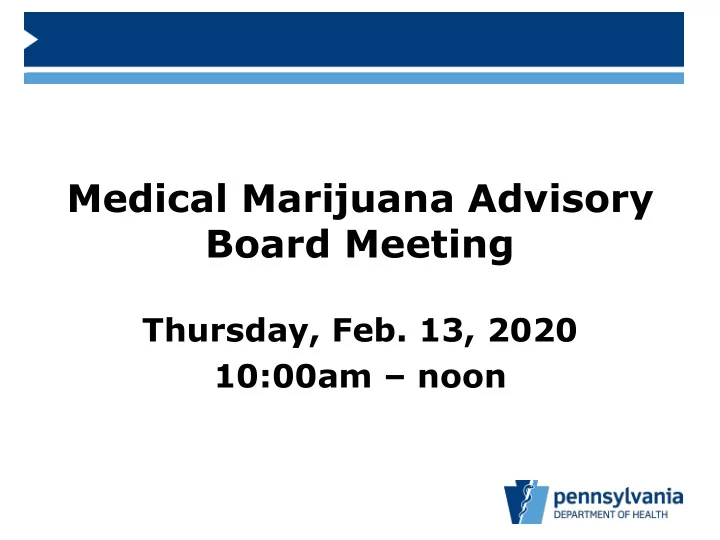

Medical Marijuana Advisory Board Meeting Thursday, Feb. 13, 2020 10:00am – noon
Program Feedback Survey One of the duties of the Pa Medical Marijuana Advisory Board is to accept and review comments from individuals and organization about medical marijuana. As part of that duty, the Patient and Caregiver Subcommittee of the Advisory Board will seek to gather comments and information from patients, caregivers and other stakeholders through a series of on-line surveys. Participation in this effort is anonymous and encouraged to help provide valuable information and understanding of how the Pennsylvania Medical Marijuana Program is serving our community and how it can be improved. Three thousand, two hundred and one people filled out the survey between January 9 th and January 28 th , when we pulled the data that is being shared in this presentation.
Program Feedback Survey What is your age? (Caregivers of minors, please fill this out on their behalf.) The survey was completed by caregivers for 20 minors under the age of 18. Respondents between the ages 18 and 35 totaled 1270, 1107 respondents were between ages 36 and 50, 614 respondents were between ages 51 and 65, and 184 respondents were 66 or older. Six people skipped this question.
Program Feedback Survey 40 (135) (145) (293) 10 41 14 32 10 10 93 17 16 16 14 22 38 12 51 30 11 60 17 33 13 38 11 259 54 38 46 58 50 80 293 82 386 61 16 175 173 410 11 72 36 19 122 (1,677) (398) (546)
Program Feedback Survey On average, the amount of money I spend on medical marijuana products per month is: $300-$499 $100-$199 Over $1,000 3.67% 21.29% 25.06% Less than $100 $200-$299 $500-$1,000 15.98% 19.99% 14.01%
Program Feedback Survey On average, the amount of money I spend on medical marijuana products per month is: Region 6 Region 2 Region 4 Region 1 Region 5 Region 3
Program Feedback Survey My preferred products form is: (Please rank in order with the numbers 1-7, with 1 being your most preferred product.) Most preferred product choices Dry Leaf Vaporization Capsules Tinctures RSO syringes Topicals Concentrates cartridges/pods
Program Feedback Survey My preferred products form is: (Please rank in order with the numbers 1-7, with 1 being your most preferred product.) Second most preferred product choices Dry Leaf Vaporization Tinctures RSO syringes Topicals Concentrates Capsules cartridges/pods
Program Feedback Survey My preferred products form is: (Please rank in order with the numbers 1-7, with 1 being your most preferred product.) Third most preferred product choices Dry Leaf Vaporization Tinctures RSO syringes Topicals Concentrates Capsules Cartridges/pods
Program Feedback Survey I feel informed about the different forms of medical marijuana and how to use them.
Program Feedback Survey I would like to have education on: (Choose all that apply.)
Program Feedback Survey My preferred method for learning about medical marijuana is: (Please rank in order with numbers 1-6, with 1 being your most preferred method.) Of the 3,083 respondents who answered this question, 2,076 chose reading website content as their most preferred method of learning about medical marijuana.
Program Feedback Survey What are your patient needs regarding medical marijuana strains? (Select all that apply.)
Program Feedback Survey What are your patient needs regarding medical marijuana strains? (Select all that apply.) Region 6 Region 4 Region 2 Region 3 Region 1 Region 5
Program Feedback Survey What are your patient needs regarding medical marijuana products? (Select all that apply.) 69.95% - Selected dry leaf 48.34% - Consistent cannabinoid, terpene, and dosage information on all labels 32.15% - Production of more strain-specific products (one strain per product) 30.69% - Production of more multi-strain products (multiple similar strains per product) 28.82% - Better patient education/inserts/ pamphlets on the product, strain, device, etc.
Program Feedback Survey
Program Feedback Survey
Program Feedback Survey
Program Feedback Survey In general, are you satisfied with the selection of products at Pa. dispensaries? Very satisfied Somewhat dissatisfied Very dissatisfied Somewhat satisfied Region 6 Region 4 Region 2 Region 3 Region 1 Region 5
Program Feedback Survey If you stopped using medical marijuana, please tell us why. (Select all that apply) 61.11% of respondents said they are unable to afford medical marijuana. 44.49% said they have not been able to find a consistent supply of the product(s) they need for their condition. 41.85% said they stopped because medical marijuana is not covered by health insurance. 21.65 said they were concerned about their legal protections under Act 16. Although the regional data was mostly consistent, in the Southwest and Southcentral regions, over 67% of respondents said they are unable to afford medical marijuana. While just between 57% and 60% in Southeast, Northwest, Northcentral and Northeast said they are unable to afford medical marijuana.
Today’s Meeting •New Business Presentation of the DOH Survey Vaping Related Illnesses Upcoming Research Summit Serious Medical Conditions
Medical Marijuana Program Updates • Patients and caregivers • Physicians • Growers/processors and dispensaries • Chapter 20
Average Order Sales Total $140.00 $135.00 $130.00 $125.00 $120.00 $115.00 $110.00 $105.00
Serious Medical Conditions Serious Medical Condition Percent Severe chronic or intractable pain of neuropathic origin or severe chronic or intractable pain. 45.02% Anxiety Disorders. 14.94% Post-traumatic stress disorder. 12.33% Cancer, including remission therapy. 6.47% Neuropathies. 6.28% Opioid use disorder for which conventional therapeutic interventions are contraindicated or ineffective, or 3.01% for which adjunctive therapy is indicated in combination with primary therapeutic interventions. Damage to the nervous tissue of the central nervous system (brain-spinal cord) with objective 2.12% neurological indication of intractable spasticity, and other associated neuropathies. Inflammatory bowel disease. 2.00% Multiple sclerosis. 1.56% Epilepsy. 1.20% Crohn’s disease. 1.16% Autism. < 1% < 1% Glaucoma. < 1% Positive status for Human Immunodeficiency Virus or Acquired Immune Deficiency Syndrome. < 1% Parkinson’s disease. < 1% Intractable seizures. < 1% Dyskinetic and spastic movement disorders. < 1% Neurodegenerative diseases. < 1% Amyotrophic lateral sclerosis. < 1% Tourette Syndrome. < 1% Sickle cell anemia. < 1% Terminal illness. < 1% Huntington’s disease.
Recommend
More recommend